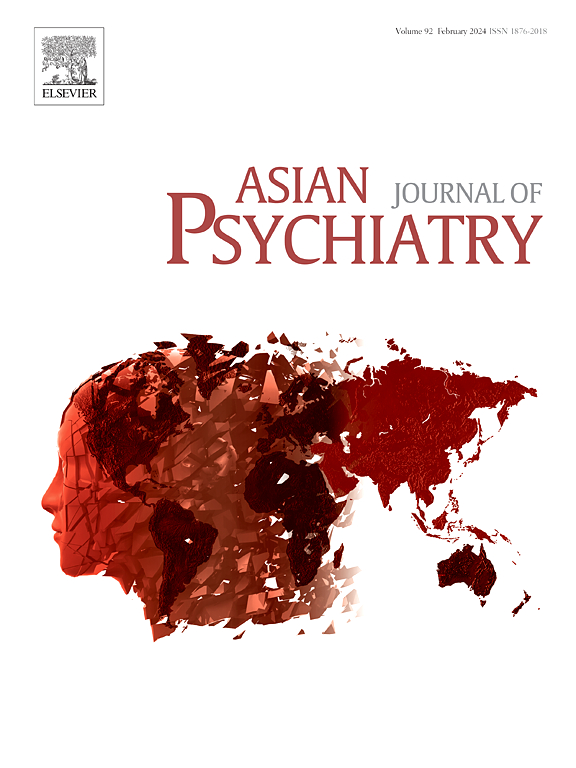Diagnostic and transition accuracy of natural language processing in high risk for psychosis individuals: A systematic review
IF 4.5
4区 医学
Q1 PSYCHIATRY
引用次数: 0
Abstract
Background
Schizophrenia spectrum disorders often emerge in adolescence or early adulthood and are a leading cause of global disability. Early identification of clinical high‑risk for psychosis (CHR‑P) can reduce comorbidity and shorten untreated psychosis duration, yet clinician‑administered tools (e.g., SIPS/SOPS, CAARMS, PSYCHS) are time‑consuming and only moderately predictive.
Objective
To systematically review the diagnostic and prognostic accuracy of natural language processing (NLP) applied to speech in CHR‑P populations, and to map methodological trends and gaps.
Methods
We searched PubMed, Scopus, and Embase through May 2025 for English or Spanish studies enrolling CHR‑P individuals by validated criteria, applying NLP to speech transcripts, and reporting quantitative metrics (accuracy, sensitivity, specificity, AUC‑ROC). Two reviewers independently screened studies, extracted data, and assessed bias with QUADAS‑2; disagreements were resolved by a third reviewer.
Results
Results: From 356 records, nine studies (eight unique cohorts; N = 353 CHR-P, 197 controls) met inclusion. Four case–control studies and one prospective cohort assessed cross-sectional discrimination of CHR-P from healthy controls, reporting accuracies of 56–95 % (AUC-ROC 0.86–0.99). Four prospective studies examined transition prediction, with accuracies ranging from 83 % to 100 %. Studies covered five languages and employed diverse NLP pipelines (e.g., LSA, Word2Vec, USE, SBERT, graph metrics, sentiment analysis). However, feature heterogeneity, small samples (≤ 50 CHR-P), varied speech tasks, and inconsistent validation limited comparability.
Conclusions
NLP‑based speech analysis shows promise as an objective biomarker for early psychosis detection and risk stratification. To advance clinical utility, future research should adopt standardized protocols, recruit larger and more diverse cohorts, and implement multicenter validation.
自然语言处理在精神病高危人群中的诊断和转换准确性:一项系统综述
精神分裂症谱系障碍通常出现在青春期或成年早期,是全球致残的主要原因。早期识别临床高危精神病(CHR - P)可以减少合并症并缩短未治疗的精神病持续时间,但临床医生使用的工具(如SIPS/SOPS, CAARMS, PSYCHS)耗时且只能适度预测。目的系统回顾自然语言处理(NLP)应用于CHR - P人群语音的诊断和预后准确性,并绘制方法学的趋势和差距。方法:我们检索PubMed、Scopus和Embase到2025年5月,通过验证标准纳入CHR - P个体的英语或西班牙语研究,将NLP应用于语音转录本,并报告定量指标(准确性、敏感性、特异性、AUC - ROC)。两位审稿人独立筛选研究、提取数据并使用QUADAS‑2评估偏倚;分歧由第三位审稿人解决。结果:从356条记录中,9项研究(8个独特的队列;N = 353个chrp, 197个对照)符合纳入。四项病例对照研究和一项前瞻性队列研究评估了健康对照中chrp的横断面歧视,报告准确率为56 - 95% % (AUC-ROC 0.86-0.99)。四项前瞻性研究检查了过渡预测,准确度从83% %到100% %。研究涵盖了五种语言,并采用了不同的NLP管道(例如,LSA, Word2Vec, USE, SBERT,图形度量,情感分析)。然而,特征异质性、小样本(≤50 chrp)、不同的语音任务和不一致的验证限制了可比性。结论基于snlp的语音分析有望作为一种客观的生物标志物,用于早期精神病检测和风险分层。为了促进临床应用,未来的研究应采用标准化的方案,招募更大、更多样化的队列,并实施多中心验证。
本文章由计算机程序翻译,如有差异,请以英文原文为准。
求助全文
约1分钟内获得全文
求助全文
来源期刊

Asian journal of psychiatry
Medicine-Psychiatry and Mental Health
CiteScore
12.70
自引率
5.30%
发文量
297
审稿时长
35 days
期刊介绍:
The Asian Journal of Psychiatry serves as a comprehensive resource for psychiatrists, mental health clinicians, neurologists, physicians, mental health students, and policymakers. Its goal is to facilitate the exchange of research findings and clinical practices between Asia and the global community. The journal focuses on psychiatric research relevant to Asia, covering preclinical, clinical, service system, and policy development topics. It also highlights the socio-cultural diversity of the region in relation to mental health.
 求助内容:
求助内容: 应助结果提醒方式:
应助结果提醒方式:


